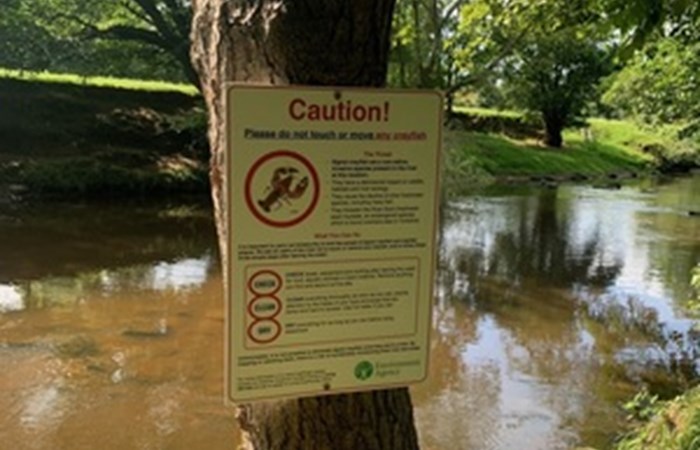Environment Agency

In partnership with the North York Moors National Park Authority, the Agency has installed biosecurity signs along the River Esk in Yorkshire after officers spotted the species during fisheries enforcement patrols.
The non-native and invasive signal crayfish damage the ecology of rivers and threaten the future of native species in the Esk - particularly its unique population of rare and endangered freshwater pearl mussel as well as fish populations.
Signals can breed and multiply quickly and cause extensive damage to banks through burrowing. They reduce overall water quality and eat almost anything, from aquatic plants to small invertebrates, fish, frogs and even each other.
The new biosecurity signs have been installed at fishing spots and public footpaths to ensure they reach as many river users as possible. The public are being urged to check, clean and dry their clothing and equipment after using the River Esk, to prevent spreading the crayfish and spores to other areas and rivers.
Advice includes:
- Check your equipment, boat, clothing and footwear after leaving the water for mud, aquatic animals and plant material. Remove anything you find and leave it at the site.
- Clean everything thoroughly as soon as you can, paying attention to areas that are damp or hard to access. Use hot water if possible.
- Dry everything for as long as you can before using elsewhere as some invasive plants and animals can survive for over two weeks in damp conditions.
- Do not remove any crayfish from the river. Handling signal crayfish, taking then out of the water or moving them to another location increases the risk of introducing them to new areas.
The Environment Agencys Allison Pierre, said:
Signal crayfish threaten the biodiversity of our rivers by reducing water quality and impacting on habitat.
We are carefully monitoring the population on the Esk, which could impact on the native freshwater pearl mussel, which is a very rare and endangered species and the Esk has the only remaining population in Yorkshire. Everyone can play their part to slow the spread.
Alexandra Cripps, Rivers Programme Manager at the North York Moors National Park Authority, said:
Invasive species can have a devastating impact on our river environments. They may outcompete native species for resources, introduce new diseases, alter habitats or disrupt the delicate balance of the ecosystem.
By adopting these simple yet effective biosecurity practices, individuals can play a crucial role in preventing the unintentional spread of invasive species and contribute to the overall health and resilience of our rivers.
The signal crayfish were first spotted by Environment Agency fisheries enforcement officers on patrol and extensive surveys have since confirmed an established population in the Esk, which flows 28 miles through North Yorkshire and enters the North Sea at Whitby.
The Esk and Coastal Streams Catchment Partnership is currently working to establish a self-sustaining population of freshwater pearl mussels in the Esk. If signal crayfish continue to spread they will threaten the population by making the habitat unsuitable for mussels and through direct predation. They could also impact on fish numbers through predation of eggs and sedimentation of spawning areas.
If you see a signal crayfish, alive or dead, leave it where it is and report it immediately to the Environment Agency on 0800 807060. If possible, take close-up photos of the crayfish to help identify the species.
It is illegal to handle or remove crayfish from the water without the correct licences.?Do not move animals or plants to a new river or lake and do not use crayfish as angling bait as this is illegal and could spread invasive species or diseases.
More information can be found on the Invasive non-n
